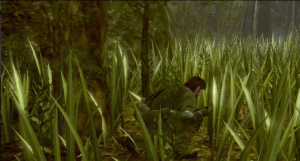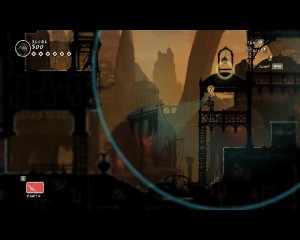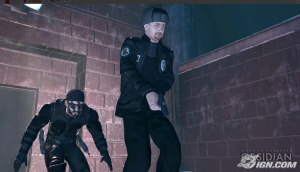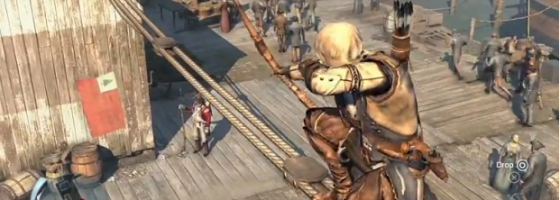Stealth can be one of the more polarizing elements in game design. Similar to health, there are several variations of what is considered “stealth.” But where the challenge of defining health was that health as a concept was not realistic. Stealth design’s issue is that it is all over the place.
The Stealth Game Play-Book:
Stealth gameplay is something that Ken and I enjoy in a variety of titles. What makes going stealthy so interesting is that it makes the player feel both very powerful and fragile at the same time.
When you sneak through an entire military base without being detected, you get the feeling of being a bad-ass just as if you ran in guns blazing and took them down. However, being stealthy means that you are usually one wrong move from being beat down by the enemies who were now on to you.
Playing a game stealth fully turns levels into puzzles, where the player must figure out the safest way to reach X without being caught.
To talk about stealth realistically, we need to break it down into what elements affect it: movement, sound and sight.
Movement and sound are self explanatory and something that every stealth game factors in. But sight is where games begin to branch off into different mechanics. Splinter Cell and Thief had lighting, Metal Gear Solid 3 introduced camouflage and Hitman went with disguises as a few examples.
Then there is the recent Batman games while having a gritty look to them, were not at all about realism, unless you count a man dressing up as a bat terrifying criminals while gliding around.
The problem with stealth in a realistic setting is that for stealth to be truly realistic it has to include all those factors and more. Why can’t I wait for the cover of darkness before sneaking in to a top secret base? Or when I knock someone out, take their disguise and walk right through the front doors.
Another knock against realism in most titles has to do with the level design which we’ll be coming back to at the end of this series. But for this part, linear level design is a killer when it comes to being stealthy. If the player only has one way to get through a level, then the act of sneaking around becomes limited.

Snake Eater introduced camouflage to the world of Metal Gear, giving players a way to control how far they blend into the environment.
Deus Ex: Human Revolution was an example of good level design in this regard: with each set piece having multiple paths for the player to find and use.
These paths were also separated by what upgrades the player choose, such as stealth generator or more agility and strength.
In a realistic setting, someone who was trying to conceal themselves would do everything within their power to remain hidden and out of sight, not relying on one mechanic over the other. With that said, at this time I have to call out the Assassin’s Creed series (at least the first two that I’ve played.)
In both titles, you were supposed to be a master assassin and expert in hiding in plain sight. However you wear an outfit that sticks out compared to the general fashion of the time and best of all was white. The color that blood would show up the most visibly on which as someone who killed people professionally would get on you pretty regularly.
Another problem with realism in stealth games is being detected. In real life, people are not psychically alerted to your presence when one person spots you. But in most games, it’s either everyone knows where you are, or no one.
The only time where that wasn’t true to my memory was in the later Metal Gear Solid games where the radiomen had to phone in to base to start the alert phase.
Moving on, while there are design issues with making the player too weak, the same could be said for making them too strong.
The Silent Killer:
Now while giving players every option to be stealthy sounds great on paper, there is one other aspect of stealth that we have to talk about: balance. As we talked about in the beginning, stealth can make the player feel both powerful and weak at the same time.
One of the big challenges with stealth in a game is figuring out just how powerful the player should be. If they can take every enemy out regardless of strength with a simple button press, then the game would become boring. But on the other hand, if every enemy was immune to the player’s stealth attacks, then that would restrict them in their options.

Mark of the Ninja was a great example of being balanced between being strong and weak when using stealth and giving the player a variety of options.
Alpha Protocol for example allowed you to play the game in a variety of ways. However if you went the stealth route, you would become overpowered by the half-way point.
One recharge-able stealth power literally allowed you to become invisible for a few seconds no matter where you were standing or moving.
Continuing this point, creating actual “stealth battles” is another big challenge. Mainly due to the fact that you are testing the player’s ability with a technique that doesn’t involve direct combat.
Of the games I’ve played there were only four good examples that came to mind.
First was Metal Gear Solid 3, where the player had to fight “The End”: a master sniper and camouflage expert. The player had to track him down in the jungle while staying undetected.
Second was Batman: Arkham City, where Batman had to fight Mister Freeze. Without going too far into spoiler territory, the player had to make use of Batman’s stealth attacks to do any kind of damage to Mister Freeze, which he would adapt to after using them.
Third was Mark of the Ninja, which as a stealth game was great for a number of reasons. One of which was turning each boss fight into an optional stealth puzzle that rewarded the player with killing them through being sneaky.
Lastly was the missing link DLC for Deus Ex: Human Revolution. Correcting the poor boss designs of the main game, in the DLC the boss could be taken down by using stealth to sneak around and take him out from behind.
Another issue with stealth balance is the enemy numbers. Some games feature levels with limited enemies while others will have an infinitely spawning army if you are detected. This is a major decision that affects game balance, as with low numbers means that the player is safe after a few stealth attacks. But having an unlimited # of guys waiting in the wings is highly unrealistic and adds difficulty.

Alpha Protocol on the other hand, turned the player into an overpowered stealth monster if you went down the stealth tree.
I liked the Batman Arkham series’ take where Batman at first could not attack the enemy groups head on.
Instead, the player had to pick them off one at a time until the remaining enemies were so scared that the player could just walk over to them and knock them out.
Stealth mechanics are one of those things that are either done incredibly well, or fail and take the whole game down with them. I would really love to see stealth design grow with the next generation, such as playing a super hero type character who must focus on protecting their secret identity just as much as fighting bad guys.
At least with that last example, it would be less suspicious compared to someone wearing all white running around on rooftops and streets and hoping that no one spots them.
Up Next: The Two-Piece Swiss Army Knife



Pingback: 5 Realistic Fallacies in Game Design: Enemies | Game Wisdom()
Pingback: 5 Realistic Fallacies in Game Design: Weapons | Game Wisdom()